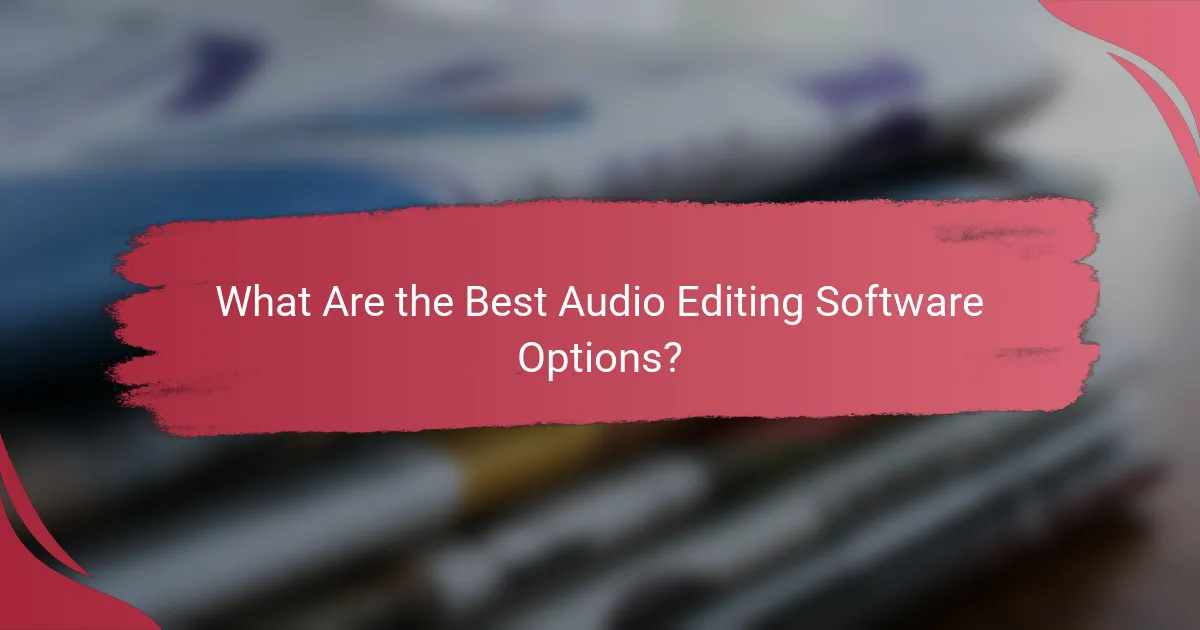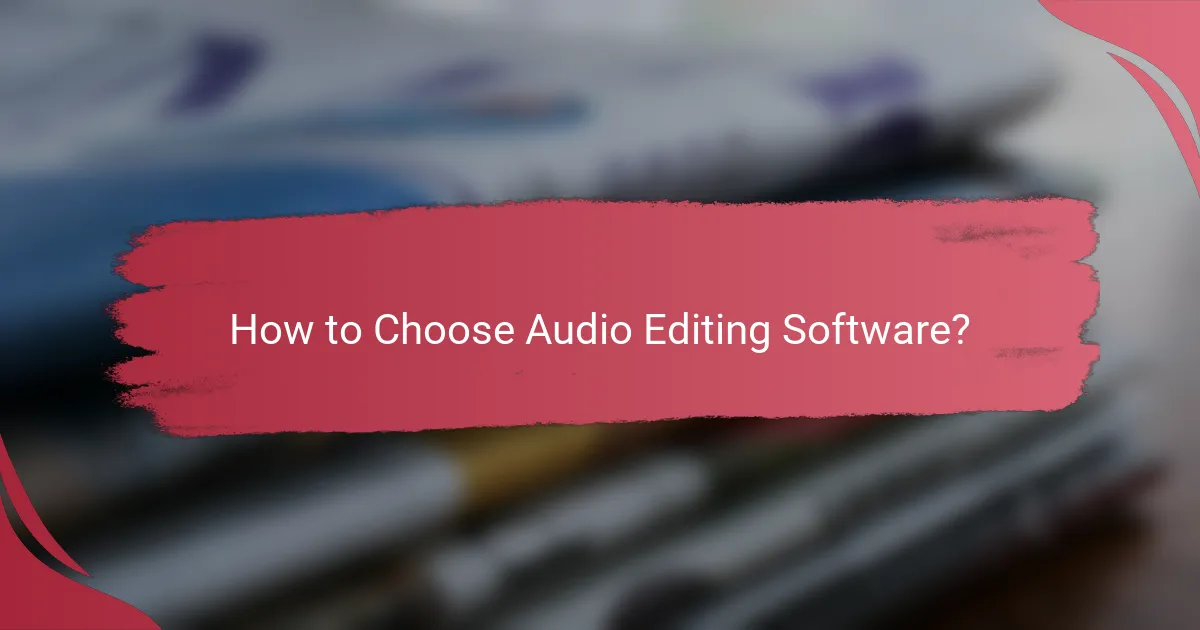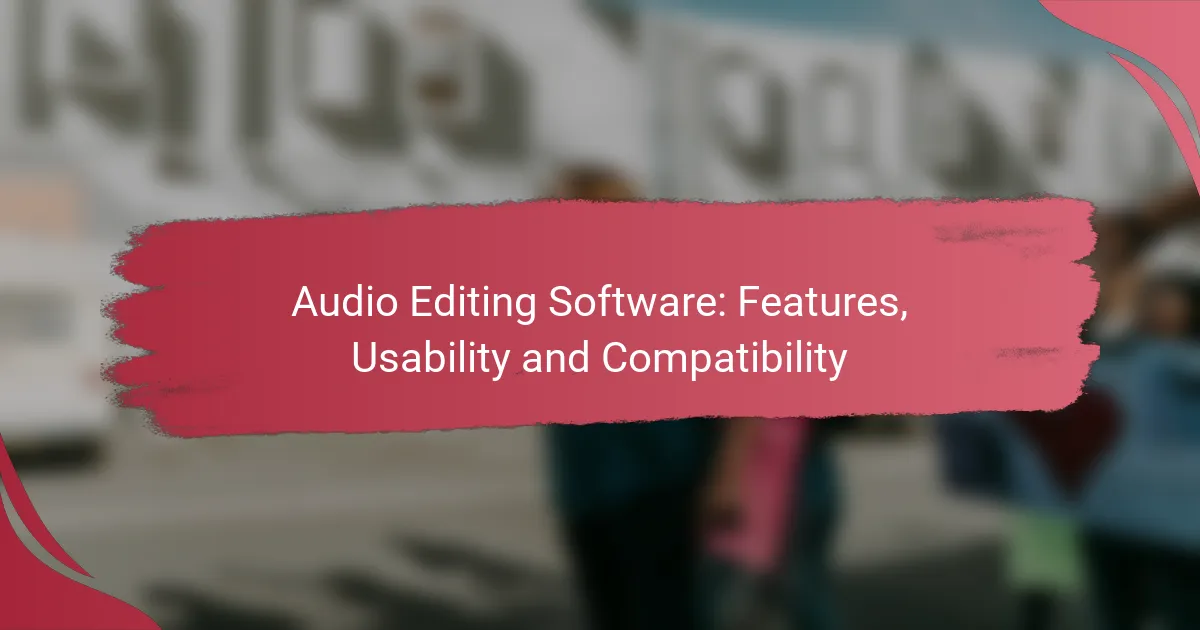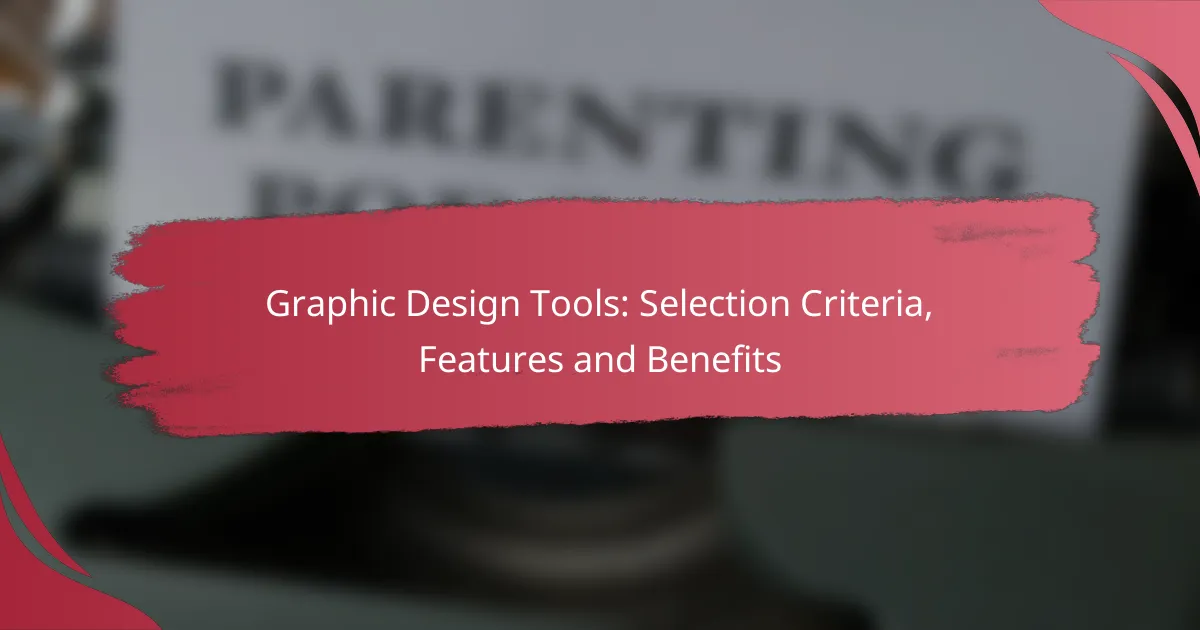Audio editing software is essential for anyone looking to create, modify, or enhance sound, whether for professional projects or personal use. With a variety of options available, such as Adobe Audition and Audacity, users can find tools that match their skill level and specific needs. Key features to consider include multi-track editing, audio effects, and compatibility with various file formats, ensuring a seamless editing experience.

What Are the Best Audio Editing Software Options?
The best audio editing software options cater to various needs, including professional sound design, music production, and basic audio editing. Popular choices include Adobe Audition, Audacity, Logic Pro X, GarageBand, and FL Studio, each offering unique features and usability suited for different skill levels and purposes.
Adobe Audition
Adobe Audition is a professional-grade audio editing software known for its robust features and seamless integration with other Adobe products. It offers advanced tools for audio restoration, multitrack editing, and sound mixing, making it ideal for professionals in the music and film industries.
Consider the subscription cost, which can be a barrier for some users, but the extensive capabilities justify the investment for serious audio work. A free trial is available, allowing users to explore its features before committing.
Audacity
Audacity is a free, open-source audio editing software that is widely used by beginners and professionals alike. It provides essential features such as recording, editing, and exporting audio files in various formats.
While it lacks some advanced features found in paid software, its user-friendly interface and extensive plugin support make it a great starting point for those new to audio editing. Be aware that its interface may feel less polished compared to commercial options.
Logic Pro X
Logic Pro X is Apple’s flagship audio editing software, tailored for macOS users. It offers a comprehensive suite of tools for music production, including virtual instruments, loops, and advanced mixing capabilities.
With a one-time purchase model, it provides excellent value for musicians and producers looking for a powerful platform. However, it is only available for Mac, which limits accessibility for Windows users.
GarageBand
GarageBand is a free audio editing software included with macOS and iOS devices, making it accessible for casual users and beginners. It features a simple interface with a variety of pre-recorded loops and instruments, allowing users to create music easily.
While it lacks the depth of Logic Pro X, GarageBand is a great tool for those starting their music production journey. Users can later transition to Logic Pro X as their skills and needs evolve.
FL Studio
FL Studio is a popular choice among electronic music producers, known for its intuitive workflow and powerful features. It offers a range of virtual instruments and effects, along with a flexible interface that allows for creative experimentation.
Pricing varies based on the edition, with options ranging from affordable to high-end, catering to different budgets. Its strong community support and extensive tutorials make it easier for new users to learn and master the software.

How to Choose Audio Editing Software?
Choosing audio editing software involves considering your budget, skill level, and the specific features you need. By evaluating these factors, you can select a program that fits your requirements and enhances your audio production experience.
Consider your budget
Your budget is a crucial factor when selecting audio editing software. Prices can range from free options to premium software costing hundreds of dollars. Determine how much you are willing to spend and explore options within that range.
Free software may have limited features but can be suitable for basic editing tasks. On the other hand, paid software often provides advanced capabilities and better customer support. Weigh the costs against the features you require to make an informed decision.
Assess your skill level
Your skill level will significantly influence your choice of audio editing software. Beginners may benefit from user-friendly interfaces and basic functionalities, while experienced users might prefer more complex tools that offer greater control and customization.
Consider starting with software that provides tutorials and community support if you are new to audio editing. For advanced users, look for programs that allow for intricate editing techniques and professional-grade output.
Evaluate feature sets
Different audio editing software comes with varying feature sets, so it’s essential to identify which features are most important for your projects. Common features include multi-track editing, effects processing, and support for various audio formats.
Make a list of must-have features, such as noise reduction, equalization, and MIDI support. Compare software options based on these features to ensure you choose one that meets your editing needs effectively.

What Features Should You Look For?
When selecting audio editing software, prioritize features that enhance your editing capabilities and workflow efficiency. Key aspects include multi-track editing, a variety of audio effects and plugins, support for multiple file formats, and options for real-time collaboration.
Multi-track editing
Multi-track editing allows you to work with several audio tracks simultaneously, which is essential for complex projects like music production or podcasting. Look for software that offers an intuitive interface for managing these tracks, enabling you to layer sounds, adjust volumes, and apply effects independently.
Consider software that supports a flexible number of tracks, as some programs may limit you to a few, while others allow for dozens or even hundreds. This flexibility can significantly impact your creative process and the final output quality.
Audio effects and plugins
Audio effects and plugins enhance your sound by adding reverb, compression, equalization, and other modifications. Choose software that includes a robust library of built-in effects and supports third-party plugins, which can expand your creative options.
Check for compatibility with popular plugin formats like VST or AU, as this will ensure you can integrate a wide range of effects into your projects. A good selection of effects can greatly improve the quality of your audio and help you achieve the desired sound.
Support for various file formats
Support for various file formats is crucial for ensuring compatibility with different devices and platforms. Look for software that can handle common formats such as WAV, MP3, and AIFF, as well as less common ones if your projects require them.
Having the ability to import and export a wide range of formats can save you time and prevent potential issues when sharing your work. Consider the formats you frequently use and ensure the software meets those needs without unnecessary conversions.
Real-time collaboration
Real-time collaboration features enable multiple users to work on the same project simultaneously, which is particularly beneficial for teams. Look for software that offers cloud-based solutions or collaborative tools that allow for seamless communication and editing.
Evaluate the ease of use of these collaborative features, as well as any limitations on the number of users or the types of edits that can be made concurrently. Effective collaboration can enhance productivity and lead to better final products through collective input and creativity.

How Usable Is the Software?
The usability of audio editing software is crucial for both beginners and experienced users. Key factors include the user interface design, the learning curve, and the availability of customer support, all of which significantly impact how effectively one can navigate and utilize the software.
User interface design
A well-designed user interface is intuitive and allows users to find tools quickly. Look for software that features a clean layout with easily accessible menus and icons. For instance, drag-and-drop functionality can enhance workflow efficiency, making it easier to manipulate audio tracks.
Consider software that offers customizable interfaces, allowing users to arrange tools according to their preferences. This flexibility can lead to a more personalized experience, catering to different editing styles and needs.
Learning curve
The learning curve varies significantly among different audio editing software. Some programs are designed for beginners, offering guided tutorials and simplified features, while others cater to advanced users with complex functionalities. Typically, beginner-friendly software can be mastered within a few hours, while more advanced tools may require days or weeks of practice.
To ease the learning process, choose software that provides comprehensive documentation and video tutorials. Engaging with community forums can also be beneficial, as users often share tips and solutions to common challenges.
Customer support options
Robust customer support is essential for resolving issues quickly. Look for software that offers multiple support channels, such as live chat, email, and phone assistance. Some companies also provide extensive online resources, including FAQs and user forums, which can be invaluable for troubleshooting.
Evaluate the responsiveness of the support team by checking reviews or testing their response times. A software provider with a strong reputation for customer service can significantly enhance your overall experience, especially when encountering technical difficulties.

What Are the Compatibility Requirements?
Compatibility requirements for audio editing software vary based on the operating system, hardware specifications, and additional software dependencies. Ensuring that your system meets these requirements is crucial for optimal performance and functionality.
Operating system compatibility
Audio editing software typically supports major operating systems such as Windows, macOS, and Linux. Each software may have specific version requirements, so it’s essential to check the software documentation for the latest supported OS versions.
For Windows users, most audio editing programs require at least Windows 10, while macOS users should be running versions from the last few years. Linux users may find fewer options, as many popular audio editing tools are primarily developed for Windows and macOS.
When selecting audio editing software, consider whether it offers cross-platform compatibility. Some programs allow projects to be shared between different operating systems, which can be beneficial for collaborative work.



